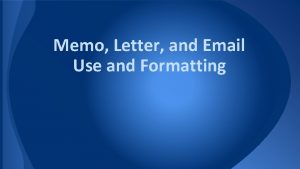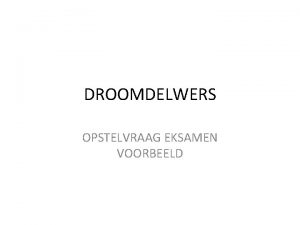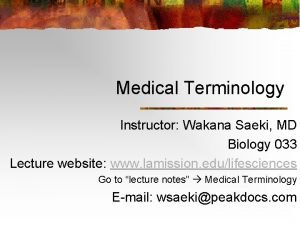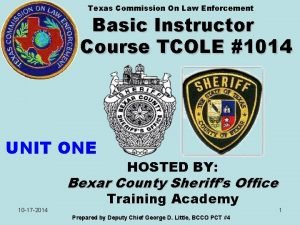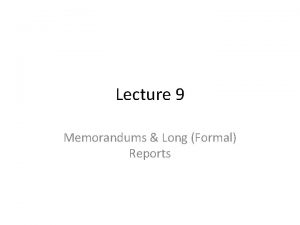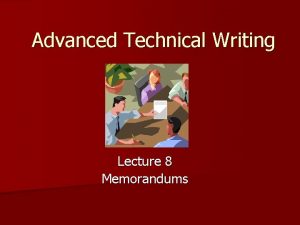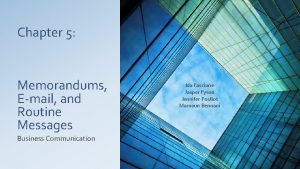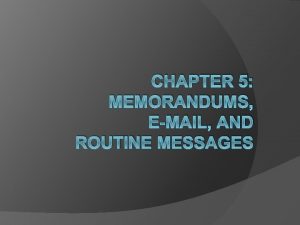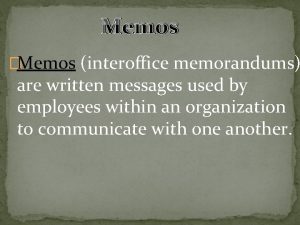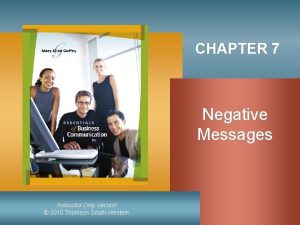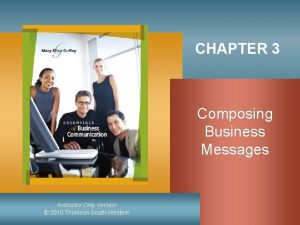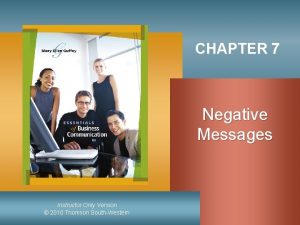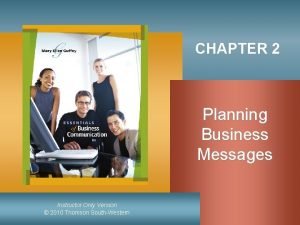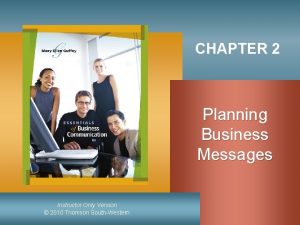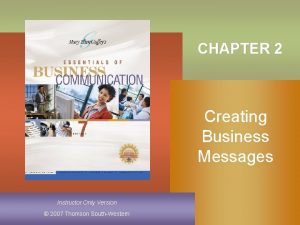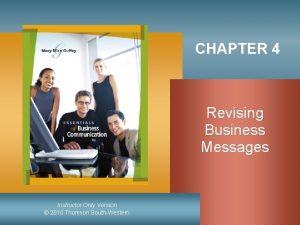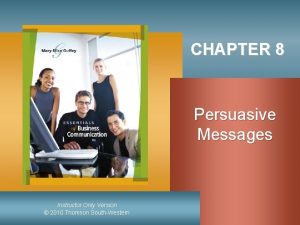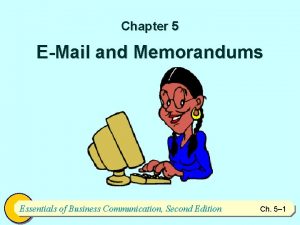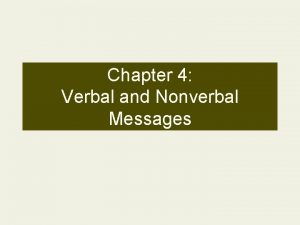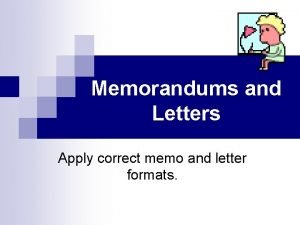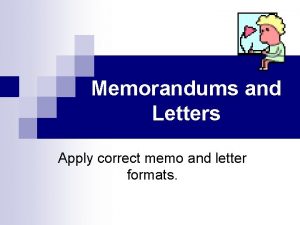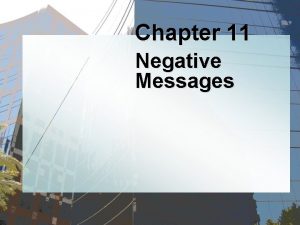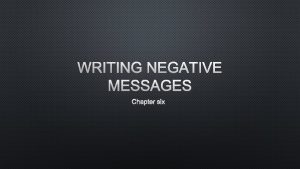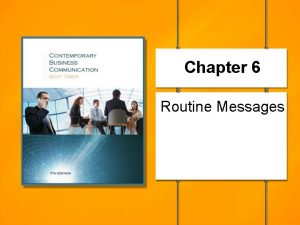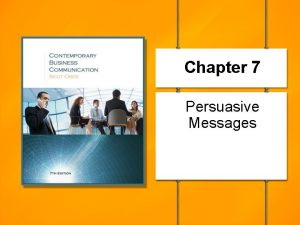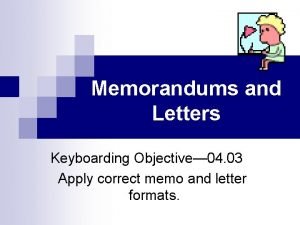CHAPTER 5 Electronic Messages and Memorandums Instructor Only







































- Slides: 39

CHAPTER 5 Electronic Messages and Memorandums Instructor Only Version © 2010 Thomson South-Western

Applying the Writing Process Phase 1 • Analysis • Anticipation • Adaptation § § § Phase 2 • Research • Organization • Composition Phase 3 • Revision • Proofreading • Evaluation Do I really need to write? What communication channel is best? Why am I writing? How will the reader react? How can I save my reader’s time? Mary Ellen Guffey, Essentials of Business Communication, 8 e Chapter 5, Slide 3

Applying the Writing Process © ISTOCKPHOTO. COM / JACOB WACKENHAUSEN Phase 1 • Analysis • Anticipation • Adaptation Phase 2 • Research • Organization • Composition Mary Ellen Guffey, Essentials of Business Communication, 8 e Phase 3 • Revision • Proofreading • Evaluation Chapter 5, Slide 4

Phase 1 • Analysis • Anticipation • Adaptation Phase 2 • Research • Organization • Composition Phase 3 • Revision • Proofreading • Evaluation § Check files, gather documentation. § Outline or list points to cover. § Compose first draft; expect to revise. Mary Ellen Guffey, Essentials of Business Communication, 8 e 8 e Chapter 5, 1, Slide 5

Phase 1 • Analysis • Anticipation • Adaptation Phase 2 • Research • Organization • Composition Phase 3 • Revision • Proofreading • Evaluation § Revise for clarity and conciseness. § Proofread for correctness. § Plan for feedback. Mary Ellen Guffey, Essentials of Business Communication, 8 e 8 e Chapter 5, 1, Slide 6

How Organizations Exchange Written Messages Electronic Paper-based messages • E-mail • Business letters • Instant messaging • Interoffice • Text messaging memos • Podcasts • Blogs • Wikis Mary Ellen Guffey, Essentials of Business Communication, 8 e Chapter 5, Slide 7

Components of E-Mail and Memos Mary Ellen Guffey, Essentials of Business Communication, 8 e © GEORGE FREY / BLOOMBERG NEWS / LANDOV Subject Line Opening Body Closing Chapter 5, Slide 8

Components of E-Mail and Memos Subject Line § Summarize message clearly and concisely. § Avoid meaningless one-word headings, such as "Help" or "Urgent. " Opening § Frontload main idea immediately. § Avoid reviewing background. Mary Ellen Guffey, Essentials of Business Communication, 8 e Chapter 5, Slide 9

Components of E-Mail and Memos Body § Organize information and explanations logically. § Cover just one topic. § Use numbered and bulleted lists. § Consider adding headings for visual impact. Mary Ellen Guffey, Essentials of Business Communication, 8 e Chapter 5, Slide 10

Components of E-Mail and Memos Closing options § End with action information, dates, and deadlines. § Summarize the message. § Provide a closing thought. § Avoid overused expressions. Mary Ellen Guffey, Essentials of Business Communication, 8 e Chapter 5, Slide 11

Formatting E-Mail Messages Guide Words Consider keying receiver’s full name with angle brackets. To: Ann Jones<ajones@peach. com> From: Entered automatically Subject: Meaningful topic summary Cc: Receiver of copy Attached: Mary Ellen Guffey, Essentials of Business Communication, 8 e Chapter 5, Slide 12

Formatting E-Mail Messages Salutation options § No salutation § Ann, Dear Ann: , Hi, or Good morning! § Include name in first line “Thanks, Ann, for your help. . . ” Mary Ellen Guffey, Essentials of Business Communication, 8 e Chapter 5, Slide 13

Formatting E-Mail Messages Body § Cover just one topic. § Use uppercase and lowercase letters. § Use short line length if message might be forwarded. Closing § Consider a complimentary closing such as Best or Cheers. § Include your name and full contact identification– especially for messages to outsiders. Mary Ellen Guffey, Essentials of Business Communication, 8 e Chapter 5, Slide 14

Formatting Hard-Copy Memos Guide Words Double-space DATE, TO, FROM, SUBJECT. Align all words after the colon following “Subject. ” Mary Ellen Guffey, Essentials of Business Communication, 8 e Chapter 5, Slide 15

Formatting Hard-Copy Memos Top and Bottom Margins § On plain paper set 1 -inch top and bottom margins. § If desired, type the company name 1 inch from the top. § A double-space below the company name, type heading “Memo” or “Memorandum. ” Mary Ellen Guffey, Essentials of Business Communication, 8 e Chapter 5, Slide 16

Formatting Hard-Copy Memos Side Margins and Spacing § Set left and right margins of 1. 25 inches. § Single-space the body. Click icon for a sample document: Mary Ellen Guffey, Essentials of Business Communication, 8 e Chapter 5, Slide 17

Formatting E-Mail Messages Open e-mail by clicking icon at right. Mary Ellen Guffey, Essentials of Business Communication, 8 e Chapter 5, Slide 18

Single-space body; double-space between paragraphs. Formatting E-Mail Messages Use angle brackets for Internet addresses Include a salutation for a friendly tone. Dear Dawn: To speed telephone installation and improve service within the main facility, we are starting a new application procedure. Service request forms will be available at various locations within the three buildings. When you require telephone service, pick up a request form at your nearest location. Fill in the pertinent facts, obtain approval from your division head, and send the form to Brent White. Write complete sentences and use upper and lowercase letters. Please call me at 451 -0593 if you have any questions about this new procedure. Best, Jay Murray, Vice President, Facilities and Operations Phone: (245) 451 -0593 ● Fax: (245) 451 -3389 E-Mail: jmurray@pro. com Mary Ellen Guffey, Essentials of Business Communication, 8 e 8 e Use a complimentary close and include your contact information. Chapter 5, 1, Slide 19

Model E-Mail Message To: Matt Ferranto mferranto@qualcom. com From: Brooke Johnson bejohnson@qualcom. com Subject: Supervising Two Assigned Interns Cc: Attached: Matt: Two interns will work in your department from September 20 through November 30. As part of their supervision, you should do the following: Develop a work plan describing their duties. Mary Ellen Guffey, Essentials of Business Communication, 8 e Chapter 5, Slide 20

Model E-Mail Message Supervise their work to ensure positive results. Assess their professionalism in completing all assigned work. Please examine the packet we are sending you. It contains forms and additional information about the two students assigned to your department. Call me at Ext. 248 if you have questions. Best, Brooke Johnson Human Resources & Development E-mail: bjohnson@telecom. com Phone: (425) 896 -3420 Mary Ellen Guffey, Essentials of Business Communication, 8 e Chapter 5, Slide 21

Using E-Mail Smartly, Safely, and Professionally u Getting Started v Content, Tone, Correctness w Netiquette x Reading and Replying y Personal Use z Other Smart Practices Mary Ellen Guffey, Essentials of Business Communication, 8 e Chapter 5, Slide 22

Using E-Mail Smartly, Safely, and Professionally Getting Started § Consider composing off line. § Type the receiver’s address correctly. § Avoid misleading subject lines. § Apply the top-of-thescreen test. Mary Ellen Guffey, Essentials of Business Communication, 8 e Chapter 5, Slide 23

Using E-Mail Smartly, Safely, and Professionally Content, Tone, Correctness § Be concise. § Don’t send anything you wouldn’t want published. § Don’t use e-mail to avoid contact. § Care about correctness and tone. § Resist humor and rage. Mary Ellen Guffey, Essentials of Business Communication, 8 e Chapter 5, Slide 24

Using E-Mail Smartly, Safely, and Professionally Netiquette § Limit any tendency to send blanket copies. § Never send “spam. ” § Consider using identifying labels, such as ACTION, FYI, RE, URGENT. § Use capital letters only for emphasis or for publication titles. § Seek permission before forwarding and beware of long threads. Mary Ellen Guffey, Essentials of Business Communication, 8 e Chapter 5, Slide 25

Using E-Mail Smartly, Safely, and Professionally Reading and Replying § § Scan all messages before replying. Print only when necessary. Acknowledge receipt. Don’t automatically return the sender’s message. § Revise the subject line if the topic changes. § Provide a clear, complete first sentence. § Never respond when you are angry. Mary Ellen Guffey, Essentials of Business Communication, 8 e Chapter 5, Slide 26

Using E-Mail Smartly, Safely, and Professionally § Don’t use company computers for personal matters unless allowed by your organization. § Assume that all e -mail is monitored. Mary Ellen Guffey, Essentials of Business Communication, 8 e Chapter 5, Slide 27

Using E-Mail Smartly, Safely, and Professionally Other Smart Practices § Use design to improve readability of longer messages. § Consider cultural differences. § Double-check before hitting the Send button. © ISTOCKPHOTO. COM / JACOB WACKERHAUSEN Mary Ellen Guffey, Essentials of Business Communication, 8 e Chapter 5, Slide 28

Best Practices for Using Instant Messaging Professionally § Learn about your organization’s IM policies. Are you allowed to use IM? § Make yourself unavailable when you need to complete a project or meet a deadline. § Organize your contact list to separate business contacts from family and friends. Mary Ellen Guffey, Essentials of Business Communication, 8 e Chapter 5, Slide 29

Best Practices for Using Instant Messaging Professionally § Don’t send anything confidential or sensitive. § Be aware that instant messages can be saved. Be careful about what you write. § Keep personal messaging to a minimum. § Show patience by not blasting multiple messages to coworkers if a response is not immediate. Mary Ellen Guffey, Essentials of Business Communication, 8 e Chapter 5, Slide 30

Best Practices for Using Instant Messaging Professionally § Keep your presence status up-to-date. § Beware of jargon, slang, and abbreviations, which may be confusing and unprofessional. § Respect your receivers by using good grammar, proper spelling, and careful proofreading. Mary Ellen Guffey, Essentials of Business Communication, 8 e Chapter 5, Slide 31

Writing Plan for Information and Procedure E-Mail Messages and Memos Subject line • Summarize the message content. Expand the subject line by stating Opening the main idea concisely in a full sentence. Mary Ellen Guffey, Essentials of Business Communication, 8 e Chapter 5, Slide 32

Writing Plan for Information and Procedure E-Mail Messages and Memos Body Provide background data and explain the main idea. In describing a procedure or giving instructions, use command language (do this, don't do that). Closing Request action, summarize the message, or present a closing thought. Mary Ellen Guffey, Essentials of Business Communication, 8 e Chapter 5, Slide 33

Date: May 1, 200 x To: Department Managers From: Waldo Hightower Subject: Hiring Ineffective Information Memo Faults: As summer approaches, we have been thinking about hiring new employees. This is to inform you that we have 1. Starts indirectly with an explanation instead of the main idea. scheduled three employment interviewing sessions. Your 2. Does not provide helpful subject line. presence is required at these sessions to help us avoid 3. Fails to develop reader benefits. making poor selections. 4. Sounds negative ("avoid making poor selections"; "your Please mark your calendar for the three times. The first presence required"; "should not have to urge you") meeting is May 3 in the conference room. The second 5. Fails to list dates for improved readability. meeting is May 9 in Office 22 (the conference room was 6. Does not include end date for returning lists. scheduled). On May 15 we can finish up in the 7. Includes wordy phrases ("This is to inform you, " "In view of the conference room. In view of the fact that your projects factneed talented new team members, I should not have to that"). urge you to attend and be well prepared. Please examine all the candidates' résumés and send me your ranking lists. Mary Ellen Guffey, Essentials of Business Communication, 8 e 8 e Chapter 5, 1, Slide 34

Improved Information Memo Date: May 1, 200 x To: Department Managers From: Waldo Hightower Improvements: Subject: Schedule for Employment Interviews 1. Includes subject line that accurately summarizes memo topic. 2. Opens directly with main idea. To help you find talented new team members for your 3. Looks at subject from reader's perspective. projects, we have scheduled the following three 4. Eliminates wordy expressions. employment interviewing sessions: 5. Lists dates in columns for improved readability. Conference Room 6. Avoids May 3 negativity; achieves positive tone throughout. May 9 7. Concludes with end. Office 22 date and reason. May 15 Conference Room 8. Emphasizes reader's benefits. Before the meetings, please examine all the candidates’ résumés. Send me your ranking lists before May 1 so that we can work together to hire the top people you select. Mary Ellen Guffey, Essentials of Business Communication, 8 e 8 e Chapter 5, 1, Slide 35

Writing Plan for Requests Subject line Summarize the request and note the action desired. Begin with the request or a brief Opening statement introducing it. Mary Ellen Guffey, Essentials of Business Communication, 8 e Chapter 5, Slide 36

Writing Plan for Requests Body Provide background, justification, and details. If asking questions, list them in parallel form. Closing Request action by a specific date. If possible, provide a reason. Express appreciation, if appropriate. Mary Ellen Guffey, Essentials of Business Communication, 8 e Chapter 5, Slide 37

Writing Plan for Replies Subject line Summarize the main information from your reply. Start directly by responding to the Opening request with a summary statement. Mary Ellen Guffey, Essentials of Business Communication, 8 e Chapter 5, Slide 38

Writing Plan for Replies Body Provide additional information and details in a readable format. Closing Add a concluding remark, summary, offer of further assistance, or request for further action. Mary Ellen Guffey, Essentials of Business Communication, 8 e Chapter 5, Slide 39

END Instructor Only Version © 2010 Thomson South-Western
 Email memo format
Email memo format Graad 11 igo pat taak
Graad 11 igo pat taak Droomdelwers langvraag 1
Droomdelwers langvraag 1 Not only the students but also their instructor
Not only the students but also their instructor Electronic field production examples
Electronic field production examples Compositional mode for digital media
Compositional mode for digital media Compositional mode for digital media
Compositional mode for digital media Scrip exchange
Scrip exchange Ac 61-98 plan of action
Ac 61-98 plan of action Virtual art instructor
Virtual art instructor Take only photographs leave only footprints
Take only photographs leave only footprints Tipos de participantes en una capacitación
Tipos de participantes en una capacitación Basic instructor course texas
Basic instructor course texas Basic instructor course texas
Basic instructor course texas Basic instructor course #1014
Basic instructor course #1014 Pepperball training manual
Pepperball training manual Instructor vs teacher
Instructor vs teacher Cisco certified trainer
Cisco certified trainer Mptc firearms
Mptc firearms Basic instructor course texas
Basic instructor course texas Basic instructor course #1014
Basic instructor course #1014 Nfpa 1403
Nfpa 1403 Human factors instructor
Human factors instructor Instructor operating station
Instructor operating station Catia instructor
Catia instructor Instructor
Instructor Tcole 1014 basic instructor course
Tcole 1014 basic instructor course Njrotc instructor vacancies
Njrotc instructor vacancies How to become an nrp instructor mentor
How to become an nrp instructor mentor Utp cable
Utp cable Wi cbrf registry
Wi cbrf registry Nra certified instructor logo
Nra certified instructor logo Naismith was an instructor of
Naismith was an instructor of Please clean your own room
Please clean your own room Tcole advanced instructor course
Tcole advanced instructor course Tcole advanced instructor course
Tcole advanced instructor course Jrotc marksmanship instructor course online
Jrotc marksmanship instructor course online Ames room
Ames room Acr medical term
Acr medical term Basic instructor course #1014
Basic instructor course #1014
